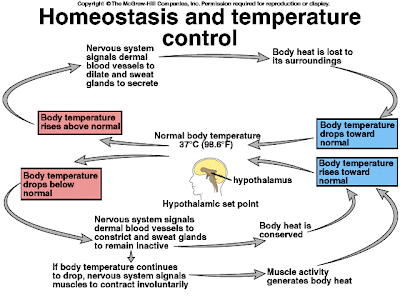Homeostasis is the maintenance of a relatively stable internal condition . The liver, the kidneys, and the brain (hypothalamus, the autonomic nervous system and the endocrine system) help maintain homeostasis. The liver is responsible for metabolising toxic substances and maintaining carbohydrate metabolism. The kidneys are responsible for regulating blood water levels, re-absorption of substances into the blood, maintenance of salt and ion levels in the blood, regulation of blood pH, and excretion of urea and other wastes.
An inability to maintain homeostasis may lead to death or a disease, a condition known as homeostatic imbalance. For instance, heart failure may occur when negative feedback mechanisms become overwhelmed and destructive positive feedback mechanisms take over. Other diseases which result from a homeostatic imbalance include diabetes, dehydration, hypoglycemia, hyperglycemia, gout and any disease caused by the presence of a toxin in the bloodstream.
Thermoregulation
Humans are warm-blooded, maintaining a near-constant body temperature. Thermoregulation is an important aspect of human homeostasis. Heat is mainly produced by the liver and muscle contractions. Humans have been able to adapt to a great diversity of climates, including hot humid and hot arid. High temperatures pose serious stresses for the human body, placing it in great danger of injury or even death. In order to deal with these climatic conditions, humans have developed physiologic and cultural modes of adaptation.
Temperature may enter a circle of positive feedback, when temperature reaches extremes of 45°C (113°F), at which cellular proteins denature, causing the active site in proteins to change, thus causing metabolism stop and ultimately death.
Glucoregulation
Humans regulate their blood glucose with insulin and glucagon. These hormones are released by the pancreas.
When blood sugar levels become too high, insulin is released from the pancreas, lowering the blood sugar levels. On the other hand, when blood sugar levels become too low, glucagon is released, increasing blood sugar levels.
If the pancreas is for any reason unable to produce enough of these two hormones, diabetes results.
Osmoregulation
Osmoregulation is the active regulation of the osmotic pressure of bodily fluids to maintain the homeostasis of the body's water content; that is it keeps the body's fluids from becoming too dilute or too concentrated. Osmotic pressure is a measure of the tendency of water to move into one solution from another by osmosis. The higher the osmotic pressure of a solution the more water wants to go into the solution.
The kidneys are used to remove excess ions from the blood, thus affecting the osmotic pressure. These are then expelled as urine
Volume
The body's homeostatic control mechanisms, which maintain a constant internal environment, ensure that a balance between fluid gain and fluid loss is maintained. The hormones ADH (Anti-diuretic Hormone, also known as vasopressin) and Aldosterone play a major role in this.
If the body is becoming fluid-deficient, there will be an increase in the secretion of these hormones (ADH), causing fluid to be retained by the kidneys and urine output to be reduced.
Conversely, if fluid levels are excessive, secretion of these hormones (aldosterone) is suppressed, resulting in less retention of fluid by the kidneys and a subsequent increase in the volume of urine produced.
If you have too much Carbon dioxide(CO2) in the blood, it can cause the blood to become acidic. People respirate heavily not due to low oxygen(O2) content in the blood, but because they have too much CO2.



0 comments:
Post a Comment